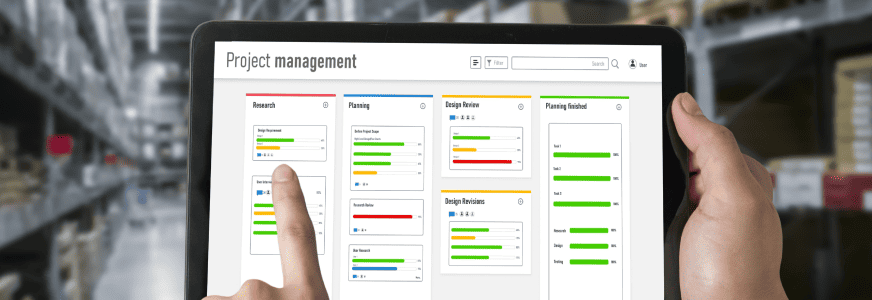
- January 11, 2022
Complete Facility Relocation Project Checklist
Relocating or expanding a manufacturing facility is complicated. It’s our hope that the following information helps you with your project!
However, these initiatives often fall outside the experience and expertise of most manufacturing executives and management. It often represents a substantial investment with high organizational visibility to the company as well.
Facility relocation is all about planning and precision.
The experts at Campbell Corp. have decades of experience helping clients move and expand their operations. And we’re here to support you with our comprehensive facility relocation checklist. We could only cram so much information into this checklist, but it’s a deep well with many complexities. So, reach out to learn more about how to apply these steps to your project.
- Evaluate the Necessity to Relocate in the First Place

Whether expanding your product offerings or gaining market share, a larger facility might not be necessary. The application of Lean Engineering reduces operational space requirements, while increasing throughput and reducing lead time.
Often, by applying Lean Manufacturing principles, manufacturers can meet their production goals right where they are with a drastically reduced investment and schedule.
Generally, the application of Lean can slash a quarter to a third of an operation’s footprint, and we’ve seen this our clients attain this range.
We’ve also seen increases to capacity by a factor of two or three in the same footprint.
How to Assess Whether You Need to Relocate?
We recommend a few different approaches when considering your options:
Option 1: Take Stock of Operational Activities
Walk your shop floor. Is there Work in Process accumulating before constrained processes?
Informally audit your operators at different periods of the day. Are they actively transforming raw materials to finished goods? Or are they looking for a tool, sourcing raw materials, seeking clarification, or engaged in any other non-value-adding activity?
Option 2: Audit Your Floor Space
The first step to estimating your operational opportunities in your current facility is to audit your existing facility to determine how much floor space you need to accommodate Work in Process and aging Raw Materials and Finished Goods inventories.
Evaluate potential space savings from increasing Inventory Turns. Once parsed of any non-essential inventory, evaluate the density capacity of your material handling equipment and fixtures.
A good resource can often be your forklift or racking vendor to explore Narrow Aisle and Very Narrow Aisle forklifts, Automated Storage and Retrieval Systems, and other applications and technologies to reduce the square footage to store Raw Materials and Finished Goods.
Evaluate your Overall Equipment Effectiveness or OEE. You can get an idea of how you’re OEE by simply walking your shop floor. Note how many operators are actively transforming raw materials to finished goods.
Do you have equipment or processes with a large amount of Work in Processes in front of it? If your operators are doing something other than adding value your customers are willing to pay for, you have manufacturing opportunity by leveraging some simple Lean tools.
- Develop Hard and Soft Relocation Goals

A successful facility layout and relocation initiative includes defining success.
At the onset, define what metrics you want to achieve after reworking your layout or relocating. Examples of these metrics can include a 50% reduction in material travel, a shortening of Lead Time from 8 weeks to 3, etc.
Keep in mind, a new facility will have soft benefits as well. While soft benefits don’t contribute to shorten the payback period, many manufacturers identify them nonetheless. These metrics can include Visual Factory elements, the Customer Experience, employee satisfaction, and many more benefits which are difficult to quantify but can be important none the less.
Create a checklist to maintain these goals throughout the lifecycle of the project.
- Identify Ideal Target Relocation Regions

Many manufacturers are simply looking to expand their current facility or relocate within their current region to reduce relocation costs and maintain their current workforce.
Some manufacturers seek operational, logistical, or fiscal incentives to relocating in a new region or country.
Proximity to vendors and customer bases can reduce the overall cost of transportation. States or counties offering relatively large monetary and support incentives can sometimes be appealing. However, these areas often have higher costs of doing business.
Countries with a relatively low cost of entry and labor can seem attractive. But the considerations to relocating to another country are often complicated and not as straightforward as they might seem on the surface. Risks include host nation inflation, exchange rate, required employee benefits–including meals and retirement contributions, unreliable utilities, protection of intellectual property–inflated finished goods inventories, longer lead times, cultural differences, and increased management oversight.
Engage legal, accounting, HR, and consulting expertise to accurately estimate your start-up budgets and schedule and realistically estimate your operational expenses while understanding your legal and operational commitments.
- Establish and Manage Your Facility Planning Team

Relocation impacts all aspects of your company: operators, production management, warehousing, sales, EHS, HR, purchasing, engineering, maintenance, etc.
Involving all stakeholders, and keeping them informed of progress, promotes success. Your team should also include any required contractors and subcontractors including millwrights, mechanical contractors, and project management professionals.
- Establish Project Scope, Budget, and Schedule

Whether building a new facility, renovating an existing facility, or simply relaying out existing operations, identify and communicate what is in scope and what is out.
Is rebuilding aging and tired equipment required to achieve your relocation goals? Investment in new equipment?
It’s at this stage of the project that we often include local architects, engineers, builders, and millwright companies as well as possible equipment vendors to assist in the realistic preparation of the Project Budget and Scope.
- Generate Production Resource List

Equipment and resource management is key to successfully relocating a manufacturing facility. We have a template we use as a starting point for our client relocations, but it’s not rocket science. The template includes an equipment ID along with equipment mechanical, environmental, foundation, and material handling requirements.
We create a digital library, and recommend this as a best practice. The library is the repository for equipment AutoCAD blocks, manuals, equipment performance requirements, consumable requirements, foundation drawings, performance tolerances, environmental specifications, and any other resources required for your equipment and operators to successfully transform raw materials into finished goods.
The Resource List and Library should be available to all design engineers and contractors involved in the design and relocation of your new facility. These documents can be included in the Contract Documents to preserve the project schedule and budget and promote project success.
- Benchmark Equipment Performance and Audit Equipment Condition

To ensure your equipment performs to the requirements of your operations, measure, test, or observe and document all critical performance elements including tolerances, rate of production, defect rate, etc.
If you’re measuring OEE, you might be tempted to think you’re already measuring the performance parameters required to specify the recommissioning requirements at your equipment’s new location, but these benchmarks are different. For instance, defect is inherent in the leveling and alignment of a machining center although expressing a specification in Thousandths is much more definitive than 1 part defect per 10,000 units defines the health and accuracy of your existing production equipment. Many of the critical specifications can be found in the equipment OEM installation instructions.
Auditing and documenting your equipment’s condition prior to disassembly and relocation can further protect your interests in memorializing condition before the equipment is relocated.
Consider including your millwright contractor in this phase of relocation.
- Design an Optimized Layout

Generally, align equipment and processes in the order required for fabrication and assembly. Consider any shared resources. Prioritize the products and processes that have the largest impact to business.
Design Raw Materials and Finished Goods Warehouses. Explore utilizing equipment to maximize the density of your warehouses including Narrow Aisle and Very Narrow Aisle forklifts, ASRS solutions, etc.
Plan spaces for any production or process requirements including material movement aisles, WIP storage,
compressor rooms, hazardous material storage, daily huddles, forklift battery / maintenance station, and anything else required by your organization.
There will also be facility related requirements including sprinkler rooms, a main electrical service area or room, code compliance including egress and fire walls, etc.
Don’t forget employee amenities including designated employee and visitor walkways. Building codes and OSHA are often inadequate at planning for your employees restroom, locker room, and breakroom needs. Depending on the size of your planned facility, consider multiple locations for employee entrance and amenities to minimize the time they spend accessing their work area and amenities.
Rethink how you use your real estate. For example, a trend for Low Volume / High Mix manufacturers includes Production Support Suites adjacent to production areas which can include areas for sales, purchasing, engineering, superintendents, and all other business functions which support a Value Stream. A new facility provides a blank slate to transform how you do business.
Review your current operations, noting your manufacturing constraints. You can lay out your facility to meet short term manufacturing goals, but what about future growth? Planning to relieve any cell or line constraints you have visibility of today will make increasing capacity in the future easier and more efficient.
Keep in mind when laying out your facility some basic principles of construction economies. It is usually more cost effective to build a square building than a rectangular one. This is due to the relatively high cost of perimeter walls compared to a supported roof structure.
- Site Planning and Design Considerations

Attention to Site Planning details is critical to the short and long term success of a facility. Planning to add a shift or for your next expansion at the initial facility design can save investment, time, and headache when your new facility is no longer adequate to meet your production needs.
Best practices include planning for existing and future employee parking, commercial and employee traffic, access for waste removal, location and access to bulk gas storage facilities, future access for large equipment replacement, or any unique considerations unique to your operations and processes.
The site planning team must consider the building codes enforced in the area relating to building setbacks, water retention, impermeable surfaces, fire department access, etc.
- Find Construction or Renovation Representation

Who at your company will represent you during construction? Owners’ representation of construction management fills many roles including a liaison between management and trades, representing the manufacturing process throughout construction or renovation activities, ensuring the work being performed meets specifications and industry quality standards, and reviewing and approving progress draws.
Depending on the size of the project, this can be a full-time job throughout construction or renovation.
Underestimating the expertise and time requirements of this role opens you up to project risk on budget, schedule, and overall success. Identify resource(s) within your organization to mitigate your risks or consider hiring a project manager to represent your interests.
- Plan Your Relocation

The ultimate goal of successful relocation planning is minimizing or eliminating the impact on your customers, which includes meeting all delivery promise dates.
Communicate the detailed relocation plan to all impacted stakeholders and highlight the impacts and potential breaks to production.
Whenever possible, start at the first process and relocate processes and equipment downstream. Sequential planning or start at the last process and relocate processes and equipment upstream.
When necessary, build product to inventory, both Work in Process and Finished Goods, to supplement the downtime associated with pieces of equipment or lines being decommissioned, relocated, PM’d, reinstalled, and recommissioned.
- Recommission Equipment

Utilizing the Benchmarking outlined earlier, recommission your equipment to the required specification and condition required to meet your operational and production requirements and goals. Recommissioning should be a formal process identified in your project schedule.
Above All, Partner With an Experienced Consultant

Facility relocation is a complicated process, and it’s important to get it right at every phase. The experts at Campbell
Corp. are available to help you plan a seamless relocation , redesign, or expansion. Email us today to get in touch,
or give us a call at (414) 421-7601.
Download E-book
"*" indicates required fields